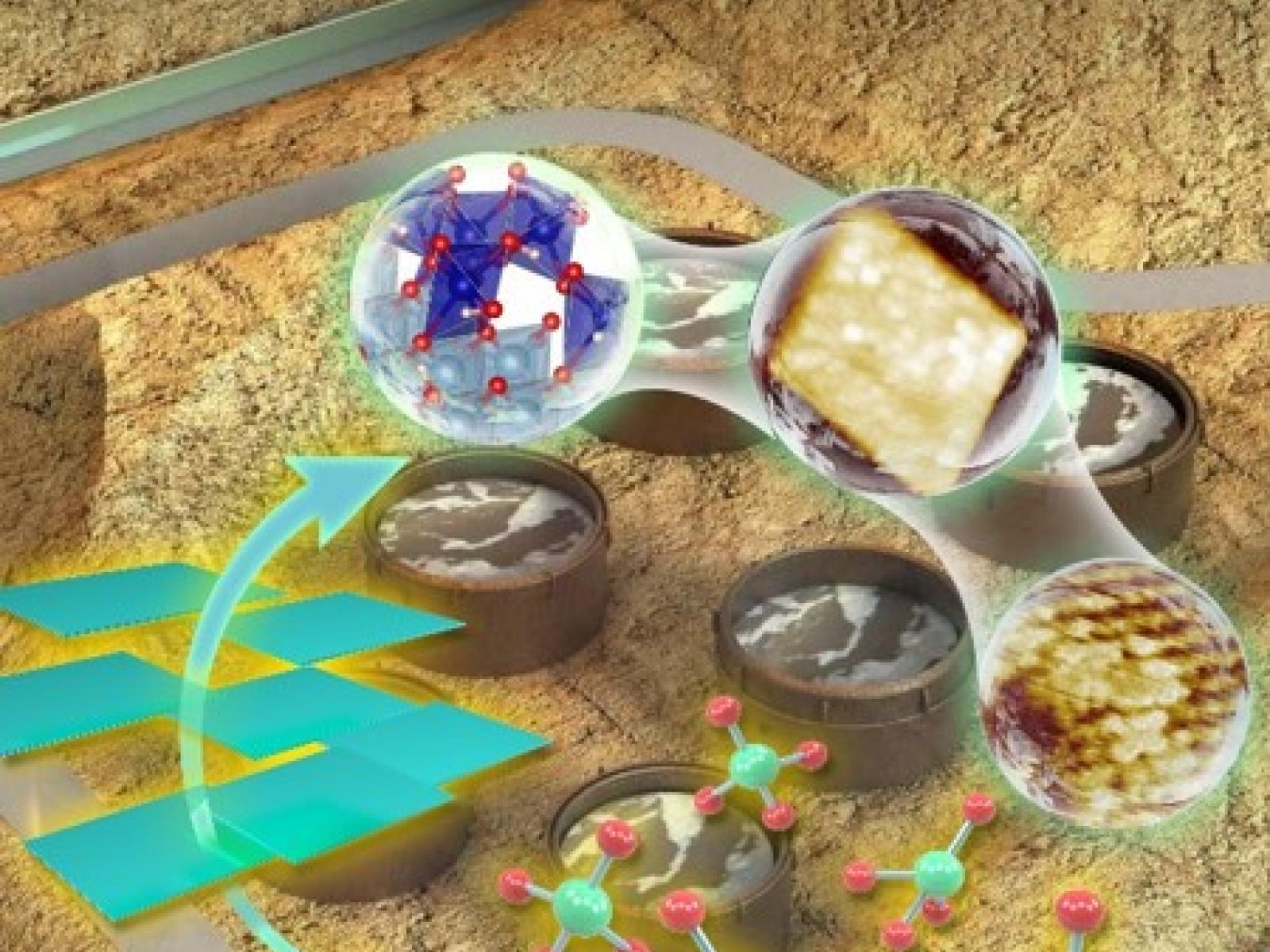Protective Coatings Impact Material Life Span
Unraveling the adsorption mechanism of Cr(III) on boehmite in highly alkaline solutions

Researchers examined—in molecular detail—Cr(III) adsorption to synthetic boehmite nanoplates in sodium hydroxide solutions.
(Illustration by Rose Perry | Pacific Northwest National Laboratory)
Nanomaterials are small particles that exist in both natural and man-made environments, including waste from industrial and energy uses. The adsorption of even trace quantities of certain dissolved metal ions can strongly impact nanomaterial reactivity, for reasons that are difficult to probe at the atomic scale. When present in sufficient amounts, the metal ions act as a protective coating around the nanomaterial. This coating impacts how well the actual nanomaterial can dissolve in other substances which can have both desired and undesired consequences.
Research conducted by scientists in the Interfacial Dynamics in Radioactive Environments and Materials (IDREAM) Energy Frontier Research Center has revealed insights about Cr(III) adsorption on aluminum oxyhydroxide nanomaterials under highly alkaline conditions, which occurs through formation of sparse Cr(III) clusters that self-assemble on the surface, enabled by surface templating.
Why it Matters
Understanding the relationship between protective coatings and nanoparticle reactivity at a fundamental level has the potential to help researchers understand and predict the selective uptake or release of metals in groundwater, or how to extend material life spans in energy applications. In the case of legacy radioactive waste, it means that it can take longer and be more costly to clean up since the coated nanoparticles are resistant to being dissolved at critical stages during processing.
The outcomes are captured in the researchers’ paper, “Cr(III) absorption by cluster formation on boehmite nanoplates in highly alkaline solution.” The paper was published in the journal Environmental Science & Technology.
Summary
Atomic force microscopy (AFM), x-ray absorption spectroscopy (XAS), and electron paramagnetic resonance (EPR) were used to determine coordination geometries of Cr(III) adsorbed to the (010) basal surfaces of boehmite. With increasing Cr loading, the observed structural motif for the surface coating is consistent with guyanaite (β-CrOOH). Specifically, the Cr(III) cluster involved corner-sharing Cr-O-Cr bonds attached to the surface with edge-sharing Cr-O-Al bonds.
What’s Next
This new knowledge can be applied to systems where chemically resistant functional materials are needed, such as selective sorbents for remediation of contaminated groundwaters.
Sponsors
This work was supported by the U.S. Department of Energy’s Energy Frontier Research Center on Interfacial Dynamics in Radioactive Environments and Materials (IDREAM).
Research Team
Wenwen Cui and Hailin Zhang (PNNL, Chinese Academy of Sciences, University of Chinese Academy of Sciences); Xin Zhang, Carolyn I. Pearce, Ying Chen, Wen Liu, Mark H. Engelhard, Libor Kovarik, Eric D. Walter, Zihua Zhu, Micah P. Prange, Sue B. Clark, Zheming Wang, and Kevin M. Rosso (PNNL); Shuai Zhang and James J. De Yoreo (PNNL, University of Washington); Meirong Zong (PNNL, Nanjing University); Steve M. Heald (Argonne National Laboratory); and Shili Zheng, Yi Zhang, and Ping Li (Chinese Academy of Sciences).
User Facilities
Published: November 30, 2020
Wenwen Cui, Xin Zhang, Carolyn I. Pearce, Ying Chen, Shuai Zhang, Wen Liu, Mark H. Engelhard, Libor Kovarik, Meirong Zong, Hailin Zhang, Eric D. Walter, Zihua Zhu, Steve M. Heald, Micah P. Prange, James J. De Yoreo, Shili Zheng, Yi Zhang, Sue B. Clark, Ping Li, Zheming Wang, and Kevin M. Rosso. 2019. “Cr(III) adsorption by cluster formation on boehmite nanoplates in highlight alkaline solution.” Environmental Science & Technology. DOI: 10.1021/acs.est.9b02693